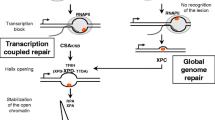Abstract
It was shown that the shuffling mechanism for transcribed genome components, which involves a template switch during the RNA reverse transcription using the L1 retroelement enzymatic machinery, is common in mammals. The occurrence frequency of the resulting chimeric retroelements in the genomes of rodents is twice as high as in the DNA of primates. Moreover, we proved that not only single but also double switches may occur in vivo, which result in the fusion of copies of three different transcripts. Many of the identified chimeras are transcribed in mammals.
Similar content being viewed by others
Abbreviations
- EST:
-
expressed sequence tag
- LINE:
-
long interspersed nuclear elements
- ORF:
-
open reading frame
- SINE:
-
short interspersed nuclear elements
- snRNA:
-
small nuclear RNA
REFERENCES
Venter, J.C., Adams, M.D., Myers, E.W., Li, P.W., Mural, R.J., et al., Science, 2001, vol. 291, pp. 1304–1351.
International Human Genome Sequencing Consortium, Nature, 2001, vol. 409, pp. 860–921.
Buzdin, A., Ustyugova, S., Gogvadze, E., Lebedev, Y., Hunsmann, G., and Sverdlov, E., Hum. Genet., 2003, vol. 112, pp. 527–533.
Kazazian, H.H., Science, 2000, vol. 289, pp. 1152–1153.
Ovchinnikov, I., Troxel, A.B., and Swergold, G.D., Genome Res., 2001, vol. 11, pp. 2050–2058.
Furano, A.V., Prog. Nucleic Acid Res. Mol. Biol., 2000, vol. 64, pp. 255–294.
Brouha, B., Schustak, J., Badge, R.M., Lutz-Prigge, S., Farley, A.H., Moran, J.V., and Kazazian, H.H., Proc. Natl. Acad. Sci. USA, 2003, vol. 100, pp. 5280–5285.
Hohjoh, H. and Singer, M.F., EMBO J., 1996, vol. 15, pp. 630–639.
Kolosha, V.O. and Martin, S.L., J. Biol. Chem., 2003, vol. 278, pp. 8112–8117.
Wei, W., Gilbert, N., Ooi, S.L., Lawler, J.F., Ostertag, E.M., Kazazian, H.H., Boeke, J.D., and Moran, J.V., Mol. Cell. Biol., 2001, vol. 21, pp. 1429–1439.
Dewannieux, M., Esnault, C., and Heidmann, T., Nat. Genet., 2003, vol. 35, pp. 41–48.
Esnault, C., Maestre, J., and Heidmann, T., Nat. Genet., 2000, vol. 24, pp. 363–367.
Buzdin, A., Gogvadze, E., Kovalskaya, E., Volchkov, P., Ustyugova, S., Illarionova, A., Fushan, A., Vinogradova, T., and Sverdlov, E., Nucleic Acids Res., 2003, vol. 31, pp. 4385–4390.
Jurka, J., Proc. Natl. Acad. Sci. USA, 1997, vol. 94, pp. 1872–1877.
Buzdin, A., Ustyugova, S., Gogvadze, E., Vinogradova, T., Lebedev, Y., and Sverdlov, E., Genomics, 2002, vol. 80, pp. 402–406.
Mouse Genome Sequencing Consortium, Nature, 2002, vol. 420, pp. 520–562.
Bibillo, A. and Eickbush, T.H., J. Mol. Biol., 2002, vol. 316, pp. 459–473.
Jamain, S., Girondot, M., Leroy, P., Clergue, M., Quach, H., Fellous, M., and Bourgeron, T., Genomics, 2001, vol. 78, pp. 38–45.
Negroni, M. and Buc, H., Ann. Rev. Genet., 2001, vol. 35, pp. 275–302.
Altschul, S.F., Gish, W., Miller, W., Myers, E.W., and Lipman, D.J., J. Mol. Biol., 1990, vol. 215, pp. 403–410.
Thompson, J.D., Higgins, D.G., and Gibson, T.J., Nucleic Acids Res., 1994, vol. 22, pp. 4673–4680.
Author information
Authors and Affiliations
Corresponding author
Additional information
Translated from Bioorganicheskaya Khimiya, Vol. 31, No. 1, 2005, pp. 82–89.
Original Russian Text Copyright © 2005 by Gogvadze, Buzdin, Sverdlov.
Rights and permissions
About this article
Cite this article
Gogvadze, E.V., Buzdin, A.A. & Sverdlov, E.D. Multiple template switches on LINE-directed reverse transcription: The most probable formation mechanism for the double and triple chimeric retroelements in mammals. Russ J Bioorg Chem 31, 74–81 (2005). https://doi.org/10.1007/s11171-005-0010-z
Received:
Revised:
Issue Date:
DOI: https://doi.org/10.1007/s11171-005-0010-z




